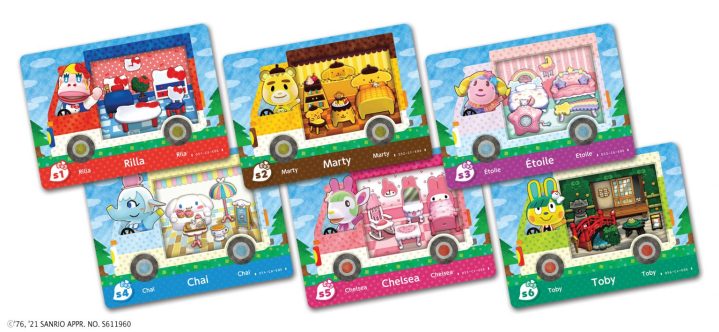If you’ve been following Animal Crossing: New Horizons since its incredibly popular launch, you may know the game does occasional crossover events with other franchises, allowing players to get rare items. The latest update added a number of items and six Sanrio villagers that you can add to your island, featuring items associated with Hello Kitty, Cinnamoroll, and more -- but getting them is a little tricky. Here’s what you need to do!
Get your hands on Sanrio Amiibo Cards
Each Sanrio-inspired villager and their associated items are unlocked by scanning physical Sanrio Amiibo collectible cards. If you want the Sanrio items, you’ll need at least one of these cards.
The cards were originally sold as a pack of all six, available in March 2021 at various locations, such as Target and Best Buy. There’s just one problem: The card packs sold out very quickly, and restocking hasn’t been very predictable. Your best bet is to avoid physical stores and shop online. Right now, you can find the card pack on Amazon as well as Walmart for around $15.

Scan the cards and collect items
Step 1: When you have the Sanrio collection pack, head to either the Nook Stop terminal in Residential Services or Photopia located on Harvey’s own island.
To get every item, visiting Photopia is better because it unlocks a few additional poster selections. If you're more interested in the villagers, use Nook Stop instead.
Step 2: Select Invite Amiibo to get started. Now you can scan each individual card by placing it near the NFC reader on your Nintendo Switch. That reader is usually under the right joystick or in the center of the Switch, depending on your model.
Step 3: Scanning a card will automatically unlock items … but they aren’t in your inventory quite yet. In New Horizons, head to the Nook Shopping center, and go to the Promotion and Poster tabs. Here you will be able to purchase the unlocked items for a certain amount of bells. Prices vary but the least expensive are around 700 to 1,000 bells, and the priciest are over 12,000.
Step 4: You can only buy five items per day in this shop. If you’re unlocking all the Sanrio items in a card pack, it will take a week or two of consistent buying to purchase all items.
Win over the Sanrio villagers
Step 1: When a Sanrio card is scanned, its associated villager should appear at the campsite near the Nook Stop Terminal. If they aren’t there, try scanning the card again at the Nook Stop Terminal and specifically inviting them. There are six Sanrio villagers available, each with their own themes: Rilla, Marty, Etoile, Chai, Chelsea, and Toby.

Step 2: Talk to the Sanrio villager you have in mind at your campsite. Like other New Horizons villagers, you’ll have to win them over with a series of crafting steps before they’ll live with you. Learn what item they want you to craft and deliver it to them. Do this once a day for three days, and you’ll be able to invite them to live on your island.
Not a fan of physical cards?
You don’t need the physical cards to get some Sanrio items, but it will take a little more work. All the Sanrio items are tradable, and since they’ve been in the game for a while, you may run across other people who have them. You can trade for them for an agreed-upon price, although the most popular items will probably have a high asking price. While this allows you to buy specific items you want, you won’t be able to get any of the Sanrio villagers this way.
Editors' Recommendations
- How to breed villagers in Minecraft
- How to watch Ninja’s New Year’s Eve stream: time, special guests, more
- Animal Crossing is the next Nintendo franchise to get the Lego treatment
- Animal Crossing: New Horizons bug guide for November 2022
- Animal Crossing: New Horizons fish guide for November 2022




